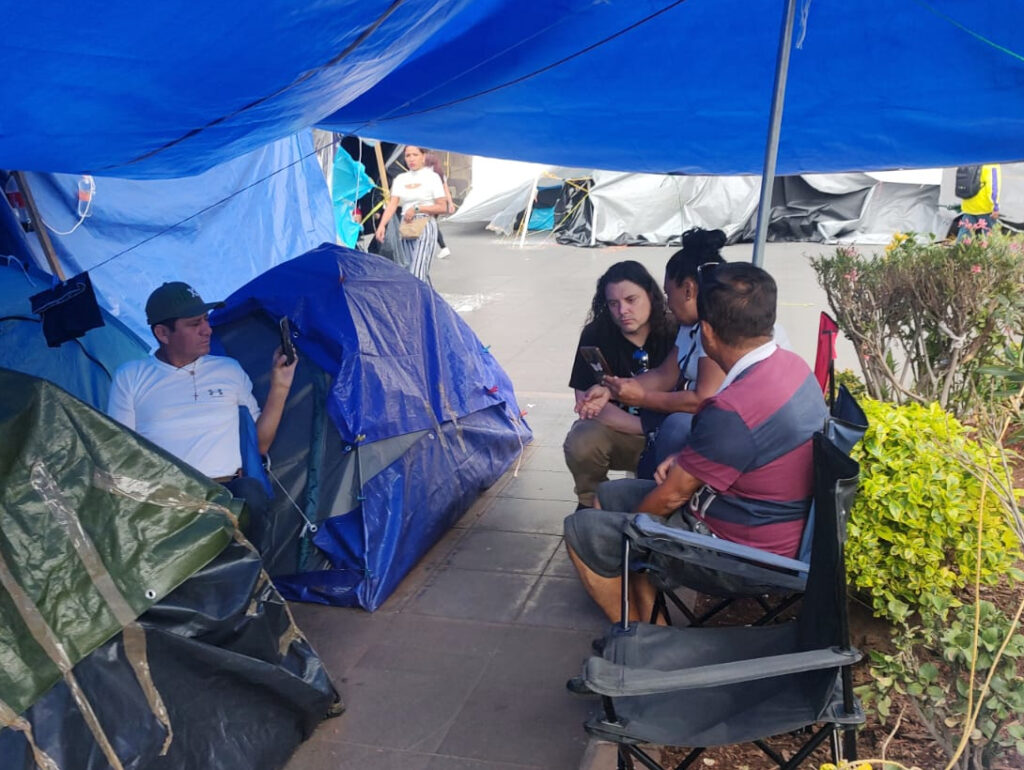
On Dec. 21, I described leaving the United States for México in my blog post “Memo from Mexico City.” I’ve since been living in the country’s southernmost and poorest state, Chiapas, intending to write a “Memo from San Cristóbal de las Casas.” That hasn’t materialized, because life is busy.
Now, though, I’ll dash off this quick, second post from Mexico City—also known as CDMX. By way of Viva Aerobús, I arrived back in the capital roughly a week ago to take care of crucial stuff, such as buying fresh New Balance kicks for running and picking up some PlayStation Castlevania games. Before I knew it, I was discussing education with teachers occupying the downtown Zócalo and watching black bloc throw rocks into government windows. As hard as I try to keep my nose in science fiction novels and my ears tuned to temperate podcasts about long-dead philosophers, such encounters seem to keep happening to me—as if I’m pursuing a slightly personalizing variant of a preternatural path that other Douglases have already snaked through, creating our mysterious, ongoingly synthesized web of time. You know how it is!
I’ll try to limit my metaphysical musings—the U.S. State Department would never have me author memo-cables—and focus on impersonally important events.
Educating everyone
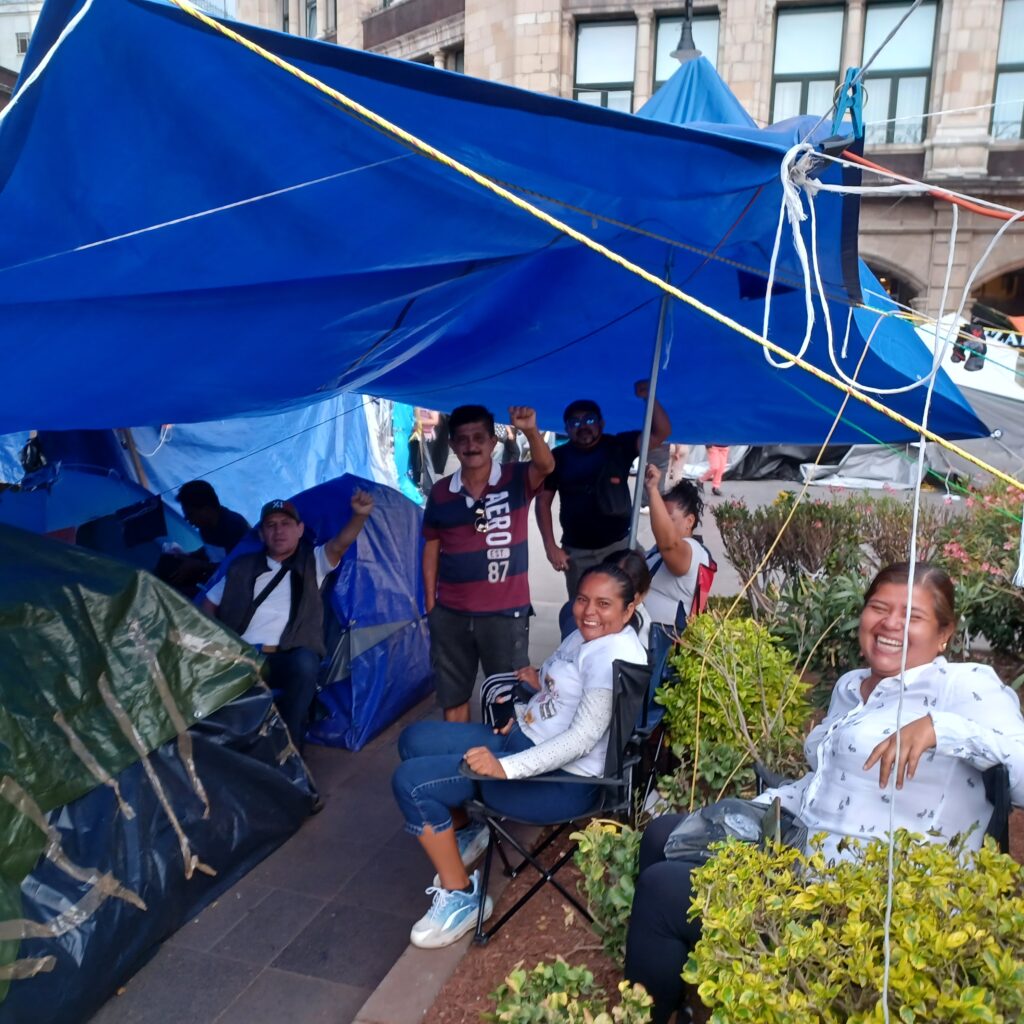
Since mid-May, teachers from around México, primarily as part of CNTE—the National Coordinator of Education Workers, a powerful, protest-heavy offshoot of the country’s largest education union—have converged on the Zócalo plaza where the presidential National Palace is, and upon surrounding streets, occupying with tents and demanding the repeal of the 2007 ISSSTE law for the sake of sustainable pensions and wages. Reportedly this protest, which shut down several terminals of CDMX’s main international airport on May 23, coincides with teacher strikes in Panama, Colombia, Argentina, Brazil.
This past weekend, some—Section 22 of CNTE among them—wanted to stop the occupation because of the authorities’ tepid offers, but the rank and file, angry at trade union leadership for murmuring of retreating, surged despite heavy rain, seizing the stage at the union leaders’ meeting-place. On June 2, CNTE temporarily shut down the San Ysidro border crossing from San Diego to Tijuana, aiming to pressure the Mexican government. Now, negotiation with the federal authorities is supposed to continue at least into the late morning of June 4, perhaps later. The former Education Secretary of Chiapas, Javier Álvarez Ramos, once a teacher himself, told La Jornada on June 3 that CNTE must propose various possible solutions, and that President Claudia Sheinbaum needs to realize the vast majority of Mexican teachers are more than 40 years old, so the pension issues—such as age of eligibility—must be addressed.
In my view, Sheinbaum deserves admiration as Mexico’s first woman president, first scientist president, for her firebrand way of repeatedly standing up to Trump (albeit not on every item), and for her support of Mexican migrants and refugees crossing the northern border. On the other hand, however, her government continues to discriminate against migrants and refugees crossing Mexico’s southern border—such as those homeless in Tapachula—she resists raising taxes on the rich, and she’s made some other dubious decisions.
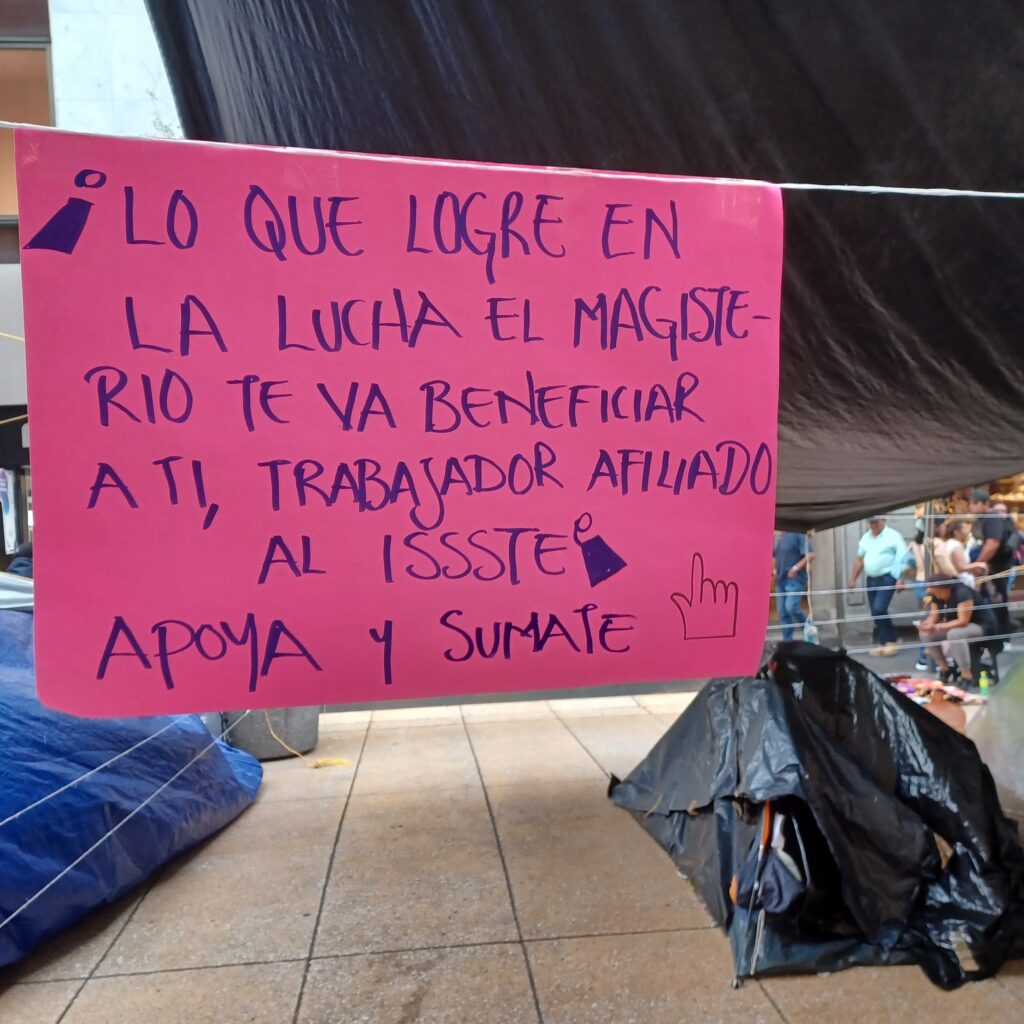
Sheinbaum, who enjoys a remarkable 80+% approval rating, has recently spoken in support of teachers in the abstract, but says budgetary constraints prevent her government from accepting CNTE’s demands. If you want to follow how the protests play out, I recommend tracking the CNTE tag on La Jornada‘s website.
I understand the teachers’ emphasis on specific financial figures, because people have to start somewhere, but sometimes, not unlike the Duffy character in James Joyce’s 1914 short story “A Painful Case,” I worry the Marxist money-über-alles stuff just has activists chasing their own tails across the centuries as wage-increases are met with price-hikes and the insistence that nothing but money can be the root of all evil continues to cloud people from seeing the social-emotional human relationships underneath the money, underneath the way our particular civilization (not the only one humanity has had!) happens to monetize, to gamify outgrouping, and obsess over moneytokens unceasingly (when was the last time you had a conversation about shame or courage to the same length people discuss property values, interest rates, or inflation? What if depictions of defense mechanisms were on the front of the business section instead of the NASDAQ? Okay, the stock market is a defen— Or to put it crudely: do lonely guys chase skirt to improve their skill at making money, or do they make more money to better chase skirt? So what’s fundamental here, pal, which is steering: pesos and pennies—or love and hate?)
But with all that background in place, what was the vibe on the ground at the Zócalo, when I went there on June 1?
The CNTE teachers seemed possessed of an almost otherworldly cheerfulness, beyond the overall increase in happiness that Mexicans have versus USians in general regardless of time, place, or protest. It reminded me of Occupy Dallas, when I brought water there nearly a decade and a half ago, or when I checked out Zuccotti Park wi—. The bullshit of extreme endosocial zero-sum seething anger and guilt and terror that dissociated populations don’t know surrounds and interpenetrates and saps them of motivation constantly, making them blame themselves and their genes instead of their tyrants large and small, was just gone, like poof, gone. Leaving smiles and jokes and abrazos (hugs). It was the another world is possible before the riot police show up.
One woman I spoke with, an elementary schoolteacher named Guadalupe, told me the photos of her schoolkids encourage her to stay at the encampment, to keep enduring the hard parts of it, because if she’s not paid enough to survive, how can she continue to nurture them? As in the image that opens this blog post, Guadalupe showed me, on her phone, pictures of her smiling kids, who looked like a Mexicanized version of the midde-schoolers I used to substitute-teach in Fort Worth and Seattle, or perhaps you could say my students were a USian-ized version of them. It really made me miss “my” middle and high school children—I still remember many of their names, years later, and wonder how they’re doing, where they are in the big web of time tracing around different paths, pulling this, repelling that, maybe finding strength as a heroic vampire-killer in some silly video game. Did any leave the United States, and if so, under what conditions—ICE? Somehow, of everything in this post section—the pensions this, the president that, the money over here, the taxes over there—the most important moment of visiting that tent was just sharing stories with Guadalupe in my stilted Spanish about my schoolkids and hearing about hers. That’s why we were both there, ultimately. Effort for humans and the future shouldn’t feel like a chore or duty, but fun, exciting, discovery (exosocial).
I talked to the teachers under the tent as best I could about how in the United States, the politicians and school administrators lie, claiming to the major media that at the poor campuses, respiratory pandemics are no worry, just open the windows, use the pink puffy soap from the bathroom dispensers. But the windows have been stuck shut for decades and the dispensers are soapless and smashed, little plastic shards all over the sticky, scuffed linoleum (or vinyl asbestos tile) floors. They said it was the same deal in places like Chiapas and Oaxaca.
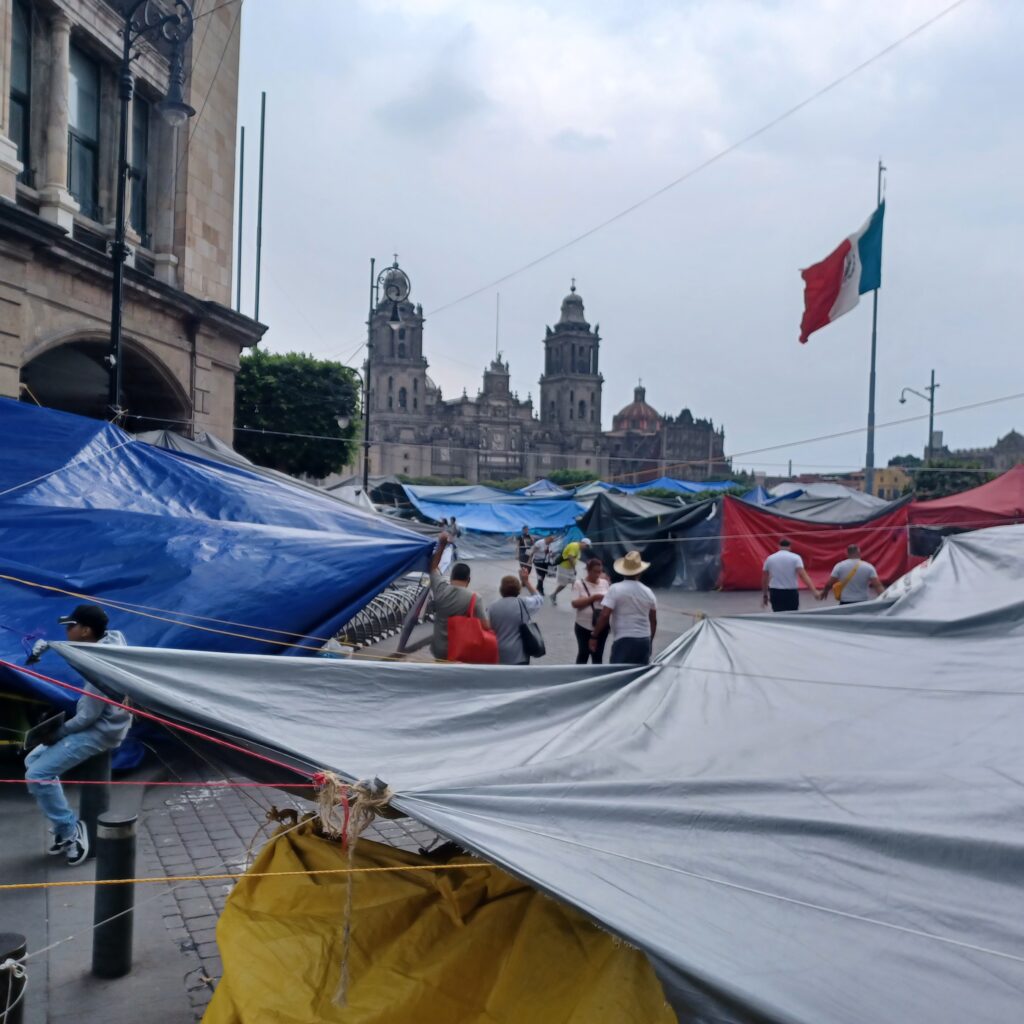
An elementary school teacher named Ulises told me, when I asked what teacher unions in the United States need to know about the CNTE protests, that we have the same enemy: the multinational corporations, the supranational oligarchy. I asked Guadalupe if there was ever any issue with software copy-protection preventing students from accessing educational materials, the United States intellectual property regime. She said not with the pen-and-paper resources, which are easy to photocopy ad libetum, but occasionally, computer software presents her classes with various paywall hurdles. (My Spanish wasn’t good enough to get any further details.)
There was a younger teacher there at the same tent who knew she was the most attractive, as did everyone else, at least from the impersonal eye that no one really has (if you truly love someone, they’re the most beautiful regardless). She put down her phone and asked about me, learned that I’m a substitute teacher and a freelance writer/journalist, and so on.
Half-jokingly, she said I should return that evening with alcohol, and other flirty things that I couldn’t translate—except by watching the body language of the others and sensing the blushing of my warming cheeks. When she found out that I plan to stay in México for years, she held out her hand, fingers down, in a pretend offer of marriage.
Apparently the weeks of tent-life—the grungy, earthy nature of occupying—had turned the teachers’ humor rather ribald, for she then said, spacing out both her hands as if measuring a large fish, “I like big ones, though, you have to have a big one.”
So I reached into my slacks and whipped out—
—my phone. “Por cierto (Indeed),” I said, gesturing at the huge Samsung in its hardshell case, “¡es muy grande!“
That wit, which needs no translation, won me applause. I didn’t go back that night with wine, however, although perhaps I should have. Well, in some other multiverse. In this one, I had a major article (extra material) under consideration at Rolling Stone to edit.
First things first.
Factional feminists?

And now, a confusing story with, maybe, a simple solution. Or not.
Certain vendor areas in Alameda Central—a huge public park in downtown CDMX, said to be the oldest public park in the Americas—are reportedly disputed, and have been for a month or so, maybe longer.
The dispute was—probably still is—between two groups of artisans selling their merchandise. One is referred to as Mazahua indigenous women; the other, feminists. Already it’s a mess. The indigenous women can’t be feminists, and none in the feminist squad are of the Mazahua?
Meanwhile, there’s a third factor: the Mexican authorities. A May 31 La Jornada article, the only news item I’ve come across about this dispute so far, says that according to the Mazahua spokesperson Elizabeth, the Mexican government is establishing a ‘green zone’ to legalize heavy marijuana-smoking in the disputed area. Heavy marijuana-smoking that’s already taking place. And already taking place, too, are worse things, according to the article: too much alcohol, urination and defecation, and so on. I’ve heard from more than one person that there’s definitely a lot of ongoing drugs & whatnot in the area, but I don’t know the extent of any associated problems or who might be causing them. Apparently the indigenous vendors have asked for a crackdown, received nothing in response, and now have to police the area themselves.
Per La Jornada, the feminist vendors were upset because the Mazahua vendors had taken over the disputed turf, preventing them from selling their merchandise—moreover, according to local onlookers and a woman apparently sympathetic to the feminist vendors with whom I briefly and unskillfully spoke in Spanish during the May 30 clash, the Mazahua artisans stole some of the feminist vendors’ stuff, and/or got rid of it, trashed it.
This video I took on May 30 briefly shows a tussle over a banner (or item of clothing?) between two women, apparently from the two separate groups. It seems another woman—I’m guessing from the ‘feminist group’ a.k.a. ‘anarchist group’—successfully de-escalated the tussle. If I’m seeing that correctly, it’s an interesting, optimistic occurence not mentioned in the La Jornada article, which quotes Elizabeth as saying the “feminists call us Indians.” (I haven’t been able to discern what the woman with the bullhorn is saying in the below video.)
Making matters worse, the feminist merchants, according to La Jornada, got no help from the authorities regarding the alleged Mazahua vigilante policing/stealing, so they decided to make their ire known dramatically. During the May 30 show of force, they threw rocks at the Post Office, breaking something like seven windows, and added graffiti to its walls: Sheinbaum is not a feminist; Femicidal state; Down with the patriarchy; Street vendor mafia!
Why target the Post Office? Because it’s there, at/near the disputed turf, and it’s part of the Mexican government. Some onlooker locals—male—expressed dissatisfaction with this to me: the post office is for all the people, they reasoned, and while femicides, they acknowledged, are a serious problem, what does the Mexican snailmail have to do with femicides? One woman onlooker local was less polite in her slur-packed description of the feminist vendor group… Another likely reason for targeting the Post Office is the intersection in front of it is quite busy, meaning taking it over helps ensure publicity.
Publicity? The messaging, unfortunately, wasn’t clear, and it wasn’t just my subpar Spanish—some onlooker locals expressed confusion as well. What does alleged theft by the Mazahua group have to do with femicides? Of course, the graffiti was presumably meant to diss the Mexican government in general, including their (as everywhere) lack of sufficient prosecution of masculinist murderers/rapists. Not so much a diss to the rival Mazahua group in particular.
This May 30 video of mine shows rocks being shipped express to the Post Office windows by the feminist group. (I still don’t know what’s being said through the bullhorn in this video, either.)
Some floated theories as to other interests that might be behind the unpopular vandalism/architectural remixing. One Mexican local I spoke with suggested that perhaps right-wing saboteurs are infiltrating feminist groups, inciting actions that will damage their credibility among the majority. Someone else suggested that could be a machination to make Sheinbaum look weak or bad: See? The homegrown anarcha-feminists don’t think Sheinbaum’s any feminist of theirs, which means the president has no real mandate to speak for women.
Personally, while I think such speculations shouldn’t be discounted, I also don’t think anyone should just automatically rule out the possibility that the dispute is exactly what it appears to be: a turf war between two rival local groups. Sometimes a cigar is just a cigar.
That said, the drone that suddenly showed up overhead was pretty spooky—I managed to film it for a few seconds, embedded below—but is that the flying device of an evil moustache-twirler orchestrating world events from within what looks like a mere taco truck, or just an overpriced sky-gizmo piloted by some bored tourist? Maybe it’s Stratfor’s, the creepy Austin-based private spy firm (now part of RANE) that I investigated and published articles about roughly a decade or so ago, including its myriad advising of multinationals, such as the Dell computer company, on how to do biz in México. Who knows?
Speculation can be important (when labelled as such), but it’s also cheap and easy—anybody can kick their feet up, spitball a few pet theories as to who the real moustache-twirlers must be, and call it a day. If I get a chance this week to talk further with either set of vendors, both of whom are out selling pretty much daily, I’ll update this post.
What’s my simple solution? Maybe if men stopped rapes and femicides, and stopped tolerating loose support or ‘joking’ support of such from their male acquaintances, or remediated their ignorance about such crimes, we wouldn’t have to decipher what this May 30 clash in front of Belles Artes was all about.
Except, maybe the graffiti on the Post Office would then just say something else—the two groups seem to have other things to fight over, after all. And are the over-the-top drugs mucking up public spaces really necessary? I don’t mean to be a prude, and I’m mostly in favor of legalizing your whatever, but why not tone it down? What’s the harm in being healthy? I know it’s a lot of work, but your best weapon in life/resistance is a strong mind.

Maybe I shouldn’t be expressing any opinions at all, and just observing. Witnessing the whole affair put me in mind of Star Trek. Those Voyager episodes with the ill-defined worldbuilding, for one thing: two stereotyped groups clashing on the planet of the week, no granular details required about their backstories. But besides that, the Prime Directive. You know, the rarely followed rule (in Star Trek or real life) that outsiders shouldn’t interfere with the internal affairs of other societies. I think witnessing—like some Ursula K. Le Guin anthropologist protagonist—is fair enough, and I don’t have any nuanced position on the Prime Directive, especially since as so many science fiction stories demonstrate that “mere” witnessing can, a la quantum mechanics, turn real quick into affecting “somebody else’s” situation. Well, I have nothing wise to say here, so moving right along.
There were a number of humorous juxtapositions that I’ll conclude this with. You know, if this were a srs bizness journadoodle article, like say about the Reorganizing Government Act of 2025, there wouldn’t be a bunch of meandering and certainly no out-of-nowhere pic of Captain Janeway from Voyager (nobody cares about Chakotay). But why can’t this just be a blog post? For me, a huge part of witnessing the May 30 scuffle was the bizarre juxtapositions, the web of life tangling up in ways that didn’t straightforwardly sell anybody’s metaphysics, except perhaps that of the surrealists.
For instance, bicyclists—some of them Rappi or DiDiFood deliverers—rode carefree around the feminist merchants’ blockades as pedestrians took quick detours and kept going, which La Jornada described with only some truth as walkers not being allowed to cross the intersection whatsoever. Some braver ones did. Anyway, it seemed surreal, as if for many passersby, the fire, the rock-throwings, the windows loudly crackling apart, the blaring bullhorns, none of that existed: it was just any other day in the capital.
To be clear, I wasn’t there the whole time, so La Jornada may have seen things I didn’t. For instance, La Jornada wrote that ambulances took some half-dozen people to the hospital, which may have been true—I didn’t see it, but I left before the scuffle ended.
Speaking of, that was another weird juxtaposition, the voyeurism: there was quite a semi-bored crowd circled around watching this whole affair like it was a baseball game or something. They’d occasionally walk a few feet over to the nearest food truck and buy some tacos, like a baseball fan grabbing a hot dog from concessions. Then they’d resume watching, perhaps commenting to their buddy next to them about how the “score” between the two groups was progressing. Rome Coliseum vibes.
Another peculiar juxtaposition. CDMX, like San Cristóbal de las Casas, has trash cans spaced perodically on sidewalks, a nice convenience indeed. While I was taking photos and videos of the feminist group’s show of force, I had an empty Electrolit—a popular drink here akin to Gatorade—in one hand. As I stood by a sidewalk covered in shattered glass, I proceeded to peer around, politely looking for a polite trash can to gently deposit the bottle into. Shards of glass everywhere, fires burning, people yelling, and still: Perdón, ¿dónde está la basura, por favor? (Excuse me, where’s the trash, please?)
Lastly, there was one particular Mexican food truck vendor dude there with a woman who seemed his wife. Asked about the scuffle, he told me this kind of thing—why not paint with a broad brush sometimes?—has been going on for years. He approached his discourse on the topic as though he were a meteorologist describing transient yet recurring weather phenomena. The feminists are mad about the Mazahua; the Mazahua are mad about the feminists; round and round; want an enchilada? Then he rolled up his newspaper and, listening to the feminist bullhorn yelling, playfully swatted his apparent wife on her culo.
Well, she didn’t seem to mind at all, or maybe I’m just an optimist. Anyway, describing protests as impersonal weather phenomena is sort of a common civic freeloader trope meant to ward off any potential engagement with the particulars of this or that incident. Strangely, being an outside-observer to this whole scuffle, made me see it a bit more like a civic freeloader, and less like the jouno-activist I am. And yet here I am writing up what particulars I managed to learn.
I wonder how many such scuffles go on, day in, day out, around the globe, minimally reported or not reported at all, the full story lost to the winds of time because no one quite crawled out on the web of ongoingly synthesized history far enough to snag the information before it was all gone, all lost…
Unique judicial elections
In the United States, all federal judges are appointed. But in several states, state-level judges are voted for. In Texas, for example, the judicial elections are even by political party. I have no opinion on whether judges should be appointed or elected or when or why; sadly, I’m under-informed on the entire issue.
But I’d be remiss not to note that on June 1, Mexicans voted for thousands of judges countrywide for the very first time. More elections for additional thousands of Mexican judges will take place in 2027, a staggered system. No other country, including Mexico previously, has ever voted for judges to such an enormous extent, so it’s quite the political experiment.
A Mexican friend who voted in the morning on June 1 told me that he and the other voters at his polling place could see information about candidates’ curricula vitae on their ballots, and that they were very enthusiastic and proud to be voting for judges. However, that’s too small a sample size to really know how it stacks up against reports that Mexicans are almost evenly split on the question of whether judges should be elected, with hundreds of judges refusing to participate in protest.
The astonishing experiment is something to keep an eye on, at the very least. Reports indicate there was low turnout—13%—and that Sheinbaum’s Morena party is winning judicial benches, including control of the Supreme Court. This would give Morena dominance over all three federal branches of government, which some are comparing to the 3/4-century of one-party rule by the right-wing PRI (Institutional Revolutionary Party), even though Morena’s Andrés Manuel López Obrador (AMLO), Sheinbaum’s predecessor, didn’t win the presidency, displacing PRI, until just seven years ago (2018).
Sheinbaum herself doesn’t see Morena’s victories as a problem. “Whoever says that there is authoritarianism in Mexico is lying,” Sheinbaum said on June 1. “Mexico is a country that is only becoming more free, just and democratic because that is the will of the people.”
Friends, FAQs, and farewell for now…
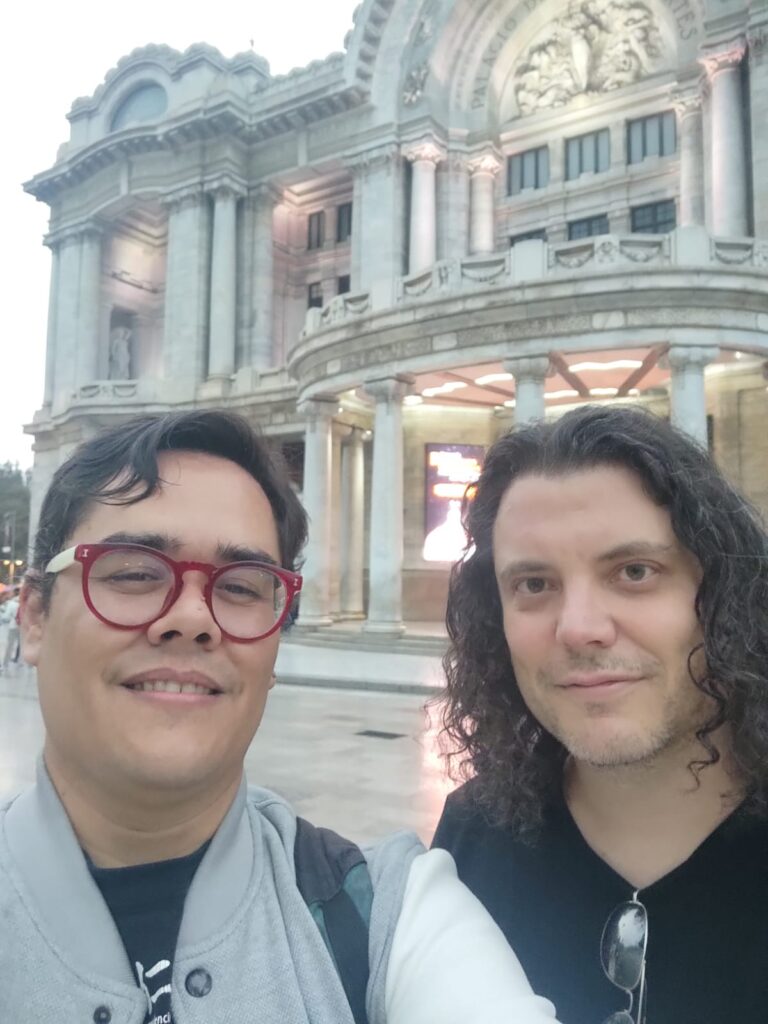
I’m staying at a hostel in CDMX a few more days before heading back to Chiapas. An elderly Christian proselytizer from the United States arrived at the hostel the day before yesterday; he says he has divine guidance and that he once prayed away a dread disease. Last night, he repeatedy warned me not only to refrain from upsetting Mexican drug cartels as a journalist, but to not upset Elon Musk or Donald Trump even just on Twitter, lest they come after me. I will not take his advice. An Eastern European woman listening to the conversation with a radiant Eastern European scowl informed the table—including him—that what he imagines Trump will do to tweeps such as myself (well, Bluesky), Putin actually does in real life to her compatriots. She also told him that some people pray hard and still die, so his God isn’t very divine. Eastern Europeans don’t fuck around.
On June 1, I hung out with Iván Maceda Mejías from Letras Con Locuras (Letters with Madness), the name of a radical mental health magazine put out by activists I discussed in my first CDMX memo. Find their second, April issue here. In the next few days, I should see Luis Gerardo Arroyo Lynn, a journalist with Mad in Mexico, an affiliate of journalist Robert Whitaker’s Mad in America. He’s a fellow vegan; well, I’m mostly vegan nowadays; travel can make it difficult at times, so I cheat a little, which I should probably find ways to fix.
I might even get to see a couple I met briefly at a downtown restaurant in December, who—in a very Mexican fashion that reminded me of rural North or East Texas—were suddenly concerned for this traveler’s well being, and invited him to their table, and gave me their WhatsApp contact info and told me to stay in touch. Why not? Maybe their curling paths crossed mine because the web of time is a variable phenomena myriad wills create rather than a Newtonian box we’re stuck inside clawing at the coordinate walls cynically because lightning or whatever supposedly birthed life … I don’t mean that If you pray hard enough, divinity will rearrange the whole universe to give you a sweet parking space, and protect you from Elon Musk and Donald Trump to boot; moreso, maybe the restaurant where I met the couple has really popular churros drawing people together because the chefs and everyone else are active participant-creators of this reality thing, except not as a metaphor: rather, it’s literally true. Not that your skin cells create/alter reality when you scratch your nose so much (though that too), but more those enigmatic perspective + will components we each uniquely have and employ to realize, actualize that which is around us, as do other powers not commonly described as living, to various extents (if that seems too hippie, picture something as impersonal as Aristotle’s Prime Mover). Somehow this spangled web we weave is easier to understand outside the United States, which sometimes feels trapped in formaldehyde.
To quickly answer a few questions I often get lately:
- Yes, my Spanish is rapidly improving. I began learning Spanish in Texas in elementary school; in high school, I flirted briefly with German and mostly switched to Latin, which I continued studying from that point on—as far as formal education is concerned—the only change being the addition of a few years of ancient koine Greek … except for a few days of French class in college, which I quickly aborted, finding that fancy language extremely silly and impossible for a Texan to pronounce. I had a few short-lived post-school attempts to learn Dutch and improve my fledgling Spanish.
No, I won’t be translating at the United Nations any time soon. I can definitely have simple conversations about the weather or a menu, and if I’m “on,” I can do a bit better, sort of like a not-particularly-literate USian middle schooler’s grasp of English. I can read a lot better than I can converse, even discerning the main ideas of a La Jornada or Cuarto Poder news article without a dictionary, for example. On the daily, my difficulty isn’t so much vocab or grammar, as it is my ear acclimating to hearing native Spanish speakers talking at a zillion kilometers per hour. Remember, even the speech of fluent native speakers in any language is typically riddled with unnoticed grammatical errors, stops and starts, and circuitous ramblings that can throw off any learner who’s desperately trying to decipher every last word properly. I hope a year from now, I’m at the point where I can have some kinda-subtle conversations on topics more substantial than asking for directions and how much otro jugo de naranja costs. Now, if editors want news articles from México, I may have more incentive to study and practice… - Yes, I hope to visit the United States. It’d be more feasible sometime between August and December, because reasons, but sorry, no promises yet. I think I wouldn’t bring electronics of any kind in, for fear of Trumpian border patrol confiscating journalists’ devices, now that I’m a rolling rock freelancer or stone or what have you. I’d just put my needed documents into an asymmetrically encrypted tarball, upload it to the secret X-marks-the-spot online, then buy a cheap laptop Stateside, put Lubuntu Linux on it, and download the tarball once back in anxiety-covered CONUS. Also would help with travel to win the lottery. I guess my biggest concern is that, while I’m there, Trump might decide to close the border on some pretext or because he woke up on the wrong side of the bed, making it hard to get back out, although I imagine he’d want to implement a tiered $ystem. Definitely need to visit and finish scanning some old documents and suchlike that I didn’t get around to dealing with when I left in December—and before the Golden Dome is erected to keep missiles out, USians in (whether just psychologically or by additional border strictures).
- Yes, you can still snailmail my Seattle PO Box—the same address on this blog’s sidebar to the right—and I’ll get a photo or scan of whatever you send eventually, and the magnificent human who checks my PO Box on my behalf can, in time, deposit checks or whatever else might need to be done with your old-school letter. There are a lot of people I owe snailmails and emails. I’ll reply soon; I haven’t forgotten! Just, moving to another country with another language, et cetera, takes a lot, while trying to keep up with news and everything else. Patience please, and thanks!
- Long-term plans? Idk, man, I have a vasectomy and no mortgage, no kids, what do I need long-term plans for? I’m gonna finish paying off my debt, slowly tapering off psychopharmaceuticals, and reading and writing. What else is there?
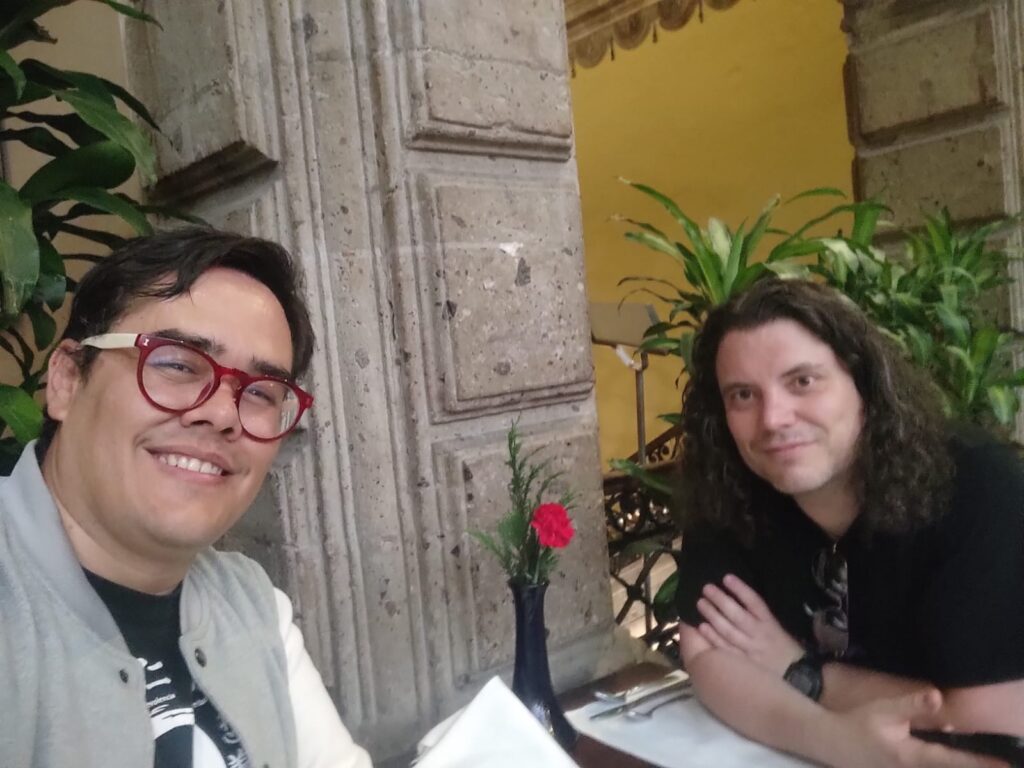


This blog post, Memo from Mexico City 2, by Douglas Lucas, is licensed under a Creative Commons Attribution-NonCommercial-ShareAlike 4.0 International License (summary). The license is based on the work at this URL: https://douglaslucas.com/blog/2025/06/04/memo-from-mexico-city-2/. You can find the full license (the legalese) here. To learn more about Creative Commons, I suggest this article and the Creative Commons Frequently Asked Questions. Please feel free to discuss this post in the comments section below, but if you’re seeking permissions beyond the scope of the license, or want to correspond with me about this post (or related topics) one on one, email me: dal@riseup.net. And gimme all your money!
 Twitter:
Twitter:
0 comments ↓
There are no comments yet...Kick things off by filling out the form below.
Leave a Comment